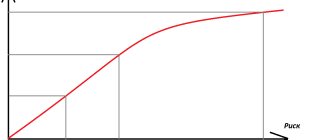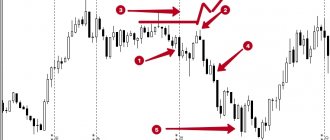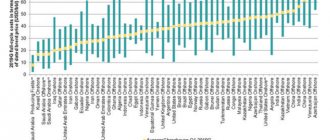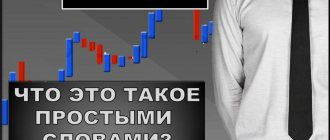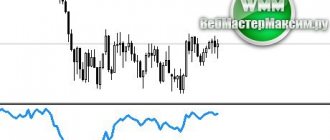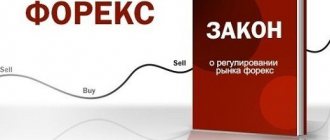Rely only on yourself
You should not look for a ready-made trading system that will suit you. It is much more effective to create it yourself. Remember the saying: “What is good for a Russian is death for a German”? It's the same in Forex. If a trading system works great for one trader, this does not mean that it will also work successfully in your hands. And there are many reasons for this:
- unfamiliar indicators or their combination, which results in a lack of understanding of the basic principles of the system;
- unacceptable level of risk;
- uncomfortable time frame;
- too volatile or, on the contrary, stable currency;
- inconvenient time for optimal entry into trades (for example, you will have to work at night or early in the morning).
In short, technical or psychological difficulties can be an obstacle to mastering someone else’s trading system. Therefore, it is better to create your own vehicle according to the rules that are clear and close to you.
Expansion phase
Creating a truly popular online commerce platform is the dream of many startups. Do you want to make this dream come true? Great! Because this part contains the information you need.
If you are planning to develop your marketplace, keep in mind large sellers as they have a number of advantages. They can handle large orders and they already have experience in how to organize the work correctly. And, most likely, buyers already trust these companies. You can start collaborating with such sellers at the very beginning of the platform’s development. In addition, they will help you cope with the lack of goods in the marketplace.
But creating an online commerce platform is not as easy as it seems. Most platforms face the “chicken or the egg” problem. Have you heard of this dilemma? If not, then below we will provide a detailed description and provide ready-made solutions that you can use for your business.
Use other people's work
But you shouldn’t completely reject the experience of other traders. Their trading systems are profitable for a reason. You should carefully study several trading vehicles (on a demo account, of course) and, perhaps, borrow some principles of their operation.
In addition, no one prohibits the use of several trading systems. For example, on EUR/USD these are the same principles, on GBP/EUR they are completely different. Which TS to use will depend on the currency pair, timeframe and, of course, your mood. You can play aggressively, trying to win a big jackpot, or you can play carefully and with little risk.
Major players
High frequency trading systems are an extremely valuable asset for large companies. They allow you to earn significant income.
Renaissance Technologies is one of the most famous hedge funds that uses exclusively automated trading.
In 2009, a programmer working for Goldman Sachs named Sergei Aleynikov stole Goldman's trading code. Aleynikov was convicted, but the charges were overturned by a federal appeals court and his conviction was overturned. However, Goldman Sachs was relentless in the case and continued to push for a conviction.
Algorithms are often extremely valuable intellectual property because in many cases the capabilities that provide an advantage often disappear if other traders start copying the strategy en masse.
Determine the currency pairs that are convenient for you
Each currency pair has its own characteristics:
- volatility (the dynamics of price changes, if the pair is too volatile, you need to enter with a smaller volume and push the stop loss a little further so that it is not knocked down by a random movement);
- spread (from 2-3 to several tens of points);
- time of active trading (for example, pairs with the euro and dollar are actively traded during the American and European sessions, and pairs with the “Australian” and “New Zealand” - during the Pacific);
- levels of resistance and support, etc.
You need to carefully study the behavior of the pair before you start trading it. You need to make sure you know what factors influence pricing, what the long-term trend is, what psychological and technical resistance and support levels are, what the broker's commission is, how volatile the pair is and in what time periods.
And here’s another interesting article: Where is it better not to invest on the Internet?
Please note that some strategies work great on some pairs and not at all on others, since price movements are explained by various factors. Therefore, determine which currency pairs your trading system is applicable to.
Determine appropriate entry and exit points
Your trading system should provide for exactly when you enter the trade: as soon as you receive a signal or when the signal is confirmed. For example, many traders prefer to open a trade only after the candle closes, even if all the indicators confirm a successful entry point. Others do not wait for confirmation, but open immediately to collect more profit. It all depends on your aggressiveness and willingness to take risks.
It often happens that the movement that has begun is a false breakout, and then the trader who opened too early loses profit. On the other hand, by opening late, you may miss a sharp rise (or fall) and will have to wait a long time for another entry point.
The same goes for closing a deal. Many simply wait until the price reaches the set take profit, others prefer not to set a limiter and wait until there are clear signals about a change in trend, and only then manually close the deal.
So, the first ones simply expect to take a set number of points, and the further fate of the pair does not interest them. The latter count on maximum income, but take great risks. And still others use a compromise option: they apply a trailing stop loss when the price reaches the level they need, so to speak, they transfer the transaction to breakeven. If they can earn more, good, if they can’t, they still achieved the target result.
Opening rules
The most effective systems pay special attention to the timing of the contract opening. This is understandable: although we are interested in the final cost, it is the correct input that allows us to increase the profitability of each transaction.
Therefore, the best models have refined rules for opening a contract:
- The price has broken through certain levels that you prepared in advance
- Focus on the shape of the candle or combining bars
- Patterns, they are also figures. We saw their education - we went to the market
The entrance also depends on the specific session. Let's say your day trading session coincides with the close of the Asian market. Then you will have to “adjust” to the conditions at the end of the day. The same thing happens when working for other foreign auctions.
Find additional signals
Using only two or three main indicators is dangerous. Some work well on trends, others - on sideways, therefore, when it is not clear what the state of the market is, relying on proven schemes is not recommended. There is a high probability of false signals appearing.
For example, if the method of two moving averages is used, then false signals appear in the flat, since these indicators are trend indicators. Therefore, it is better not to use moving averages at all during sideways movement, or to connect additional indicators. For example, stochastic or MACD, which are flat indicators.
Additional “helpers” will significantly enrich your trading system, make it more flexible, reduce the number of false signals and generally increase profits.
How to launch an online marketplace from scratch?
Come up with an idea and test it
Think about your business model:
- Select the segment you will work in
- Select a monetization model
- Research the e-commerce software market to choose an online marketplace platform
Launch a marketplace MVP
Find sellers and buyers
Launch your online marketplace
- Polish your marketplace based on user feedback
- Tell us about your online marketplace in the media
Determine your risk level
This advice can be formulated differently: stop! They are especially useful if you do not constantly sit in front of a monitor or in an excessively volatile market (however, when it is “stormy”, it is better to refrain from opening transactions altogether). Determine how much you can afford to lose from your capital. It is considered optimal if in one transaction you risk no more than 3-5% of your capital. The most extreme option is 10%. No more.
And here’s another interesting article: Why binary options are a scam, and how to avoid losing money
Factor potential losses into your trading system. Determine in points what loss you are willing to suffer. And to level out potential losses, set a take profit 2 times larger than the stop. With increased profits you will compensate for losses if you open unsuccessfully several times.
And under no circumstances move your stop loss! This is a very bad strategy!
Some traders set the limiter at a certain number of points, others tie its value to the nearest support or resistance levels, highs or lows, Fibonacci levels, etc. It all depends on how comfortable it is for you.
Don't get carried away with trading on small time frames
There is a lot of noise on the TF from 1 to 15; volatile pairs can behave unpredictably. Therefore, building your trading system on these timeframes is highly not recommended. The favorite period of scalpers is the 1-5 minute time frame, but such traders cannot count on long-term and large profits, and the risks are too high.
At higher periods (from 30 minutes), market noise is compensated to a minimum. This is where serious money is made, but you will have to wait quite a long time for profit. You may have to wait out major drawdowns.
Trading is different in each period. Decide on your needs and capabilities, and only then choose the timeframe that suits your style.
Advantages of the trading system
There are several obvious advantages of trading using the strategy:
- Statistical advantage. The trader knows that if he follows the TS rules, there will be more profitable trades than unprofitable ones, and as a result he will be in the black (if this has been confirmed by preliminary backtesting). Even if there has been a string of losing trades, the trader knows that the situation will most likely improve;
- A trader does not need to guess every time whether it is worth or not to open a trade. It only follows the signals of the vehicle;
- It is easier for a trader psychologically. Greed, fear and the desire to win back by increasing the lot are easier to control when there are clear rules that make the trader more of a performer than a decision maker.
We can say that the strategy turns Forex trading from an exciting activity into a routine, but most traders come to the market to make money, not to play, and the TS helps them achieve their main goal.
Analyze multiple timeframes
Naturally, we are talking about higher timeframes, but it’s also worth taking a closer look at smaller ones:
- larger ones will give you a general idea of the trend, for example, it may turn out that the apparent reversal on the 15-minute is just a correction within the hourly timeframe, and it is dangerous to open before the level is broken;
- smaller ones will tell you when a trend reversal is emerging - it is quite possible that your hourly candle has not yet closed, and the 15-minute period has already drawn a clear reversal pattern.
The most optimal moment to enter is when an entry signal is available on several time frames at once. So it is better to include in the trading system the ability to use indicators in different periods. It is possible that you will need different “helpers” on each timeframe - this is normal. The main thing is to exit at the signal on your “main” period - this way you will protect yourself from obvious mistakes.
Another argument in favor of analyzing higher timeframes is that organizations and individuals with significant capital trade on them. Namely, volume bets “move” the market and give it general movement.
Consider the news
This advice actually contains several recommendations:
- If possible, liquidate open positions before the release of important news, since they (for example, the same Non Farm) have a strong impact on the market, and fluctuations can simply “blow away” your stop loss or drive you into losses if it is absent;
- news helps to catch the general trend, for example, when there was an unclear situation with Greece in 2014, the euro was steadily falling, and to make money you could put it on sale almost at any time;
- the price takes everything into account, and if the news is not very important or “stretched out” in time, then it will not cause sharp fluctuations, if you have an idea in which direction the price will move, then you can safely open a deal, for example, the British pound sterling fell all day until There was a vote on Britain's exit from the European Union.
And here’s another interesting article: Review of the “black” broker HQBroker: reviews and negative experiences
To track news, it is convenient to use the trader’s calendar - it is available on the website of any more or less large broker. To receive economic news, you can simply follow leading financial sites or set up a parser for the most important events.
conclusions
The development of a two-sided platform for online sales is a very promising project due to its advantages, such as a scalable and justified business model. However, creating such a platform can require a lot of time, effort and money. But if you are serious about such a project, then nothing is impossible.
The Dinarys team hopes that you have been inspired by this article and have learned some useful information from it. To get a free consultation at any stage of online platform development, simply fill out the form via the link.
Be careful on Fridays and Mondays
These days, as well as at the end of the month, pairs are especially volatile. And if on normal days it gives good signals, on these days it may fail. The reason is simple: at the end of the week and at the end of the month, many large players close their positions, and this undoubtedly affects the value of currency pairs.
The same goes for Mondays. These days, many traders, on the contrary, open transactions; trading is especially active during the European and American sessions. It is better for an inexperienced trader to hold back his capital and practice on a demo account.
Also, some traders do not want to overpay the triple swap from Wednesday to Thursday, and liquidate their positions in the middle of the week shortly before the close of the session. This may also have an impact on prices.
Mandatory components of a trading strategy
Each strategy should include certain points that together will ensure trading stability:
- Rationale. This is the main idea on which the trading strategy is built. It is the foundation on which all other components are based;
- Currency pairs for trading;
- Timeframe and trading time (trading session);
- Entry rules (signals to open a position);
- Exit rules. How stop loss and take profit are set;
- Trading lot volume and risk limitation.
If all these parameters are taken into account, you can begin testing the strategy on a history or demo account.
